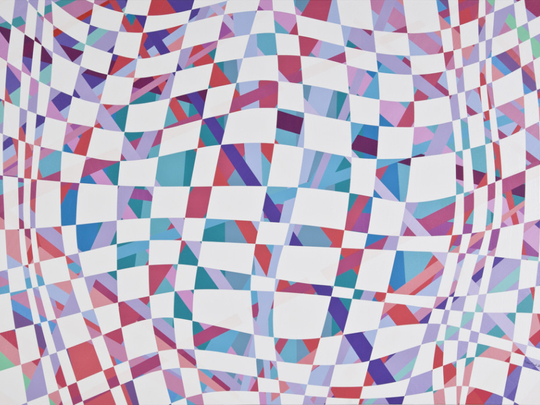
Over the last decade, Mouteea Murad has been exploring relativity, spatiality and the visual dynamic of geometric forms through his colourful, abstract paintings. The Sharjah-based Syrian artist takes inspiration from the geometric forms and motifs of Islamic art to combine formalism with spirituality in his compositions. As he moves towards greater abstraction, Murad has experimented with automatic brushwork, the illusionist perspective of Op art, the symmetry of geometric abstraction and the collapsing planes of Suprematism. But his recent work reflects his interest in mathematics, with the forms and lines being defined by algebraic formulas and their geometric application; and it has a greater focus on space and dimension.
Murad continues his experimentation with the use of mathematics in geometric abstraction in his latest exhibition, “Thresholds”, organised by curator Murtaza Vali. The show features a series of vibrant large-scale works that are all based on the Fibonacci number sequence.
Here, Murad has used the growth patterns resulting from this sequence to create a sense of movement and the illusion of expanding space in his compositions. By applying the Fibonacci series to grid-like patterns that partially conceal the interactions of polygons and lines, he has created a feeling of depth in the paintings. The squares of the grids look like windows to a hidden world, and as they become larger the paintings appear to swell and contract, inviting viewers to cross the threshold into the realm beyond.
As always, each of Murad’s paintings is titled “Trial”. But the subtitles offer some clues about the emotions and sensations he wants to convey. For example, in “Trial 125, Rainbow and Light and Love” the canvas is divided into seven distinct planes of similar hues with intersecting lines that can be read as different colour fields where light dances in sequence. The white bands that position these areas of colour reach the upper and lower edges of the painting, eventually fading into a white background, suggesting infinity. Although the composition stretches across the canvas, the grid seems suspended, as though held in mid-air by opposite poles. The sensation of rain and light is thus expressed in the interplays of colour and line, and the element of “love” is perhaps a reference to the gravitational force that keep these elements in place.
Jyoti Kalsi is an arts-enthusiast based in Dubai.
“Thresholds” will run at Ayyam Gallery, Alserkal Avenue, Al Quoz, until January 7.












